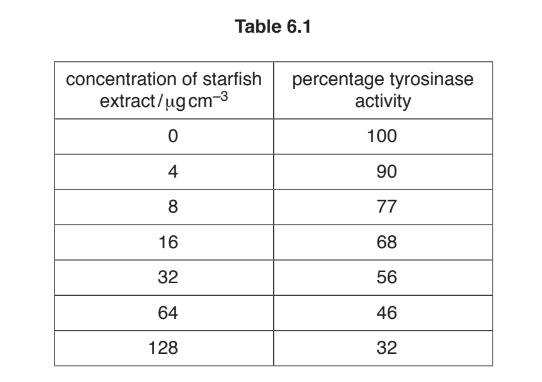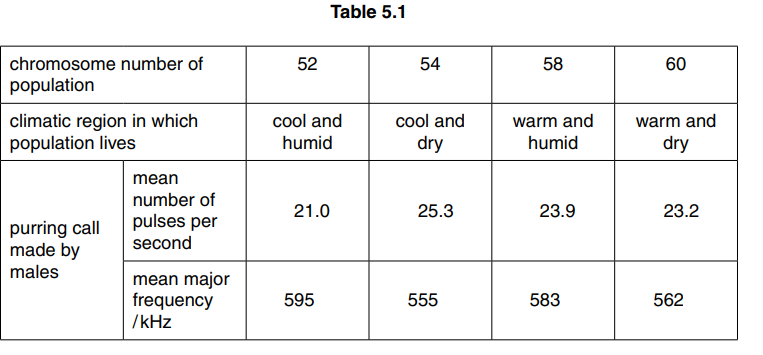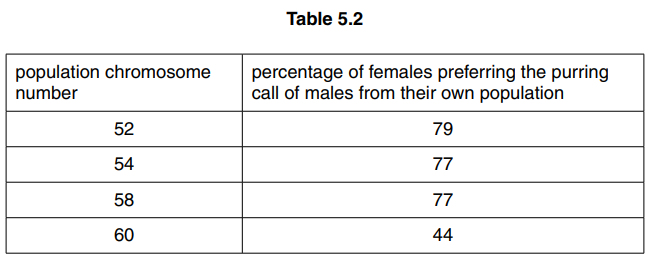Question [Maximum marks: 11]
The black pigment melanin, which contributes to hair, skin and eye colour, is produced by cells
known as melanocytes.
(a) In people with albinism, the melanocytes do not produce melanin. Albinism is caused by an
inherited gene mutation.
(i) Outline how a gene mutation may occur.
(ii) Albinism is an autosomal recessive condition.
Explain what is meant by the term recessive.
(iii) Using appropriate symbols, draw a genetic diagram to show how a man and a woman, who both produce melanin, could have a child with albinism.
(b) Melanin is produced by the action of the enzyme tyrosinase on the amino acid tyrosine.
A study was carried out to investigate the effect of an extract of the starfish Patiria pectinifera
on the activity of tyrosinase.
Table 6.1 shows the results of this study.

Suggest how the starfish extract affects the activity of tyrosinase.
Answer/Explanation
Answer: 6(a)(i) any four from: 1 random / spontaneous ;
2 change in, base / nucleotide, sequence of DNA ;
3 ref. to base, substitution / deletion / addition ;
4 ref. to frame shift / AW ;
5 AVP ; e.g. mutagens / UV light / ionising radiation
6(a)(ii) allele only expressed, when a dominant allele not present / in a homozygote or
allele not expressed in a heterozygote ;
6(a)(iii) symbols explained ; e.g. A = allele for, melanin production / normal pigment
a = allele for, no melanin production / albinism
parental genotypes ;
e.g. Aa and Aa
offspring genotypes identifying child with albinism as aa ;
e.g. (AA Aa Aa) aa
6(b) any three from:
1 the greater the concentration of extract, the lower the activity of tyrosinase ;
A inversely proportional
2 extract acts as an inhibitor / enzyme inhibited ;
3 binds to, active site / allosteric site, (of tyrosinase) ;
4 ref. to alters pH ;
5 extract denatures tyrosinase ;
Question
Mole rats, Spalax ehrenbergi, are mammals that live in groups in underground burrows. They are blind, and communicate with each other through sound and scent. Males make a purring call when they are attempting to persuade females to mate with them.
In Israel, the mole rats found in different parts of the country all look identical. However, there are actually four different populations with different chromosome numbers, which live in different climatic regions.
These are shown in Table 5.1.
This table also shows information about the purring calls used by the males in each population. The calls of the males were analysed by measuring the number of sound pulses per second, and also the frequencies of the sounds that they made.

(a) Explain why the chromosome number of each of the four populations of mole rats is an even number.[2]
(b) Researchers investigated how female mole rats from each of the four populations responded to purring calls made by males from the same population, and by males from different populations.
A female was placed midway between two loudspeakers, and recorded calls from two males were played to her simultaneously. The researchers noted which loudspeaker the female moved towards. This was repeated with many different females from each
population. The results are shown in Table 5.2.

With reference to Table 5.2, describe the extent to which female mole rats show a preference for the purring calls of males from their own population.[2]
(c) With reference to the data in both Table 5.1 and Table 5.2, discuss whether these four populations of mole rats should be classified as different species.[4] [Total: 8]
Answer/Explanation
Ans:
5 (a) 1 two (complete) sets of chromosomes / diploid/ 2n ;
2 one of each chromosome, from each parent/ maternal and paternal ;
3 to allow (homologous) pairs to form during, meiosis / prophase 1/reduction division ;
(b) most/ high %/ more than 70%,
of females in three populations prefer calls from their own population ;
less than half/ 44%, of females in, one population/ population 60,
prefer calls from their own population ; ora
(c) yes
1 different chromosome numbers ;
2 cannot interbreed to form fertile offspring/ hybrids infertile ;
3 (because) not all chromosomes will be able to pair in meiosis ;
4 live in different, habitats / climatic regions
OR
geographical isolation ;
5 (so) unlikely to interbreed/reproductively isolated ;
6 most females prefer males from their own population ; ora
7 differences in mating, call/ behaviour ;
no
8 some females, willing to mate with/ prefer, males from other populations ;
9 phenotypically / morphologically, similar ;
Question
(a) Describe the behaviour of chromosomes during meiosis. [9]
(b) Outline the differences between structural and regulatory genes. [6] [Total: 15]
Answer/Explanation
Ans:
10 (a) I ref. to nuclear envelope I names of stages
meiosis I
1 chromosomes, condense/thicken/ spiralise ;
2 homologous chromosomes pair/ bivalents form ;
3 crossing over/ described ;
4 chiasma(ta) ;
5 spindle fibres / microtubules, attach to/pull, centromeres / kinetochores ; allow once in mp5 or in meiosis II
6 bivalents line up on, equator/ mid-line ; A pairs of homologous chromosomes
7 independent assortment (of homologous pairs) / described ; A random assortment
8 chromosomes move to, two ends of cell/ poles ; A (pairs of) homologous chromosomes separate
meiosis II
9 (individual) chromosomes / pairs of chromatids, line up on, equator/ mid-line ;
10 at right angles to first equator ;
11 centromeres divide ;
12 chromatids separate ; A chromatids move to (opposite) poles
13 ref. to haploid/ chromosome number halved/ one set of chromosomes ; A n for haploid
(b) I polypeptide throughout
structural gene
1 structural protein/ enzyme/rRNA ; A any named protein other than a transcription factor (e.g. transporter/receptor/ named hormone/ immunoglobulin/ haemoglobin/etc.) R if any of these are identified as product of regulatory gene
2 named, structural protein/other protein/ enzyme, or tRNA ; R named protein if function wrongly described
3 idea that needed for, structure/ function, of cell ;
regulatory gene
4 (product) controls, gene expression/ transcription ; A promote/ prevent/ start / stop, gene expression or transcription
5 (codes for) transcription factor/DNA-binding protein ;
6 binds to, promoter/ operator/DNA response element ;
7 stops / allows, binding of RNA polymerase ;
8 ref. to repressor/repressible ; A silencer
9 ref. to inducer/ inducible ; A activator/ enhancer
10 named example of regulatory gene ; A lac repressor/DELLA repressor/ homeobox or homeotic or Hox gene
